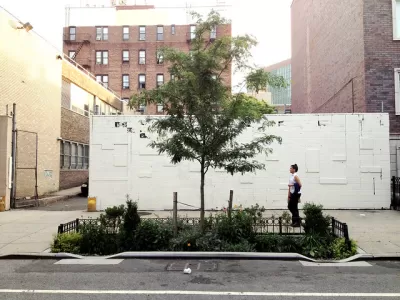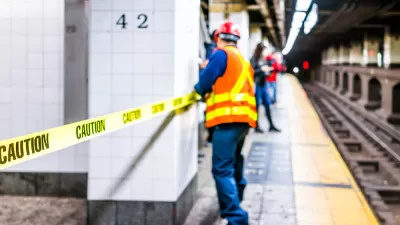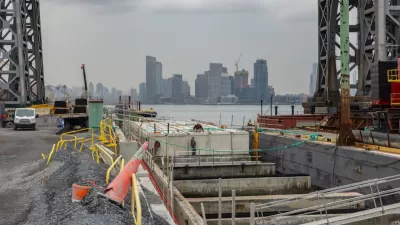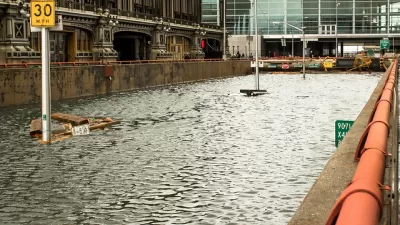To reduce the severity of disruptive subway flooding, the city can implement street-level solutions that absorb and redirect water before it reaches the train tunnels.

As climate change all but assures more catastrophic flooding in New York City, "experts say the city and the MTA can at least work on mitigating the worst of the floods by going green. Literally." To protect the city's subways and mitigate future floods, writes Dave Colon, "it’s incumbent on the city to create streets and sidewalks that can actually absorb water."
New York's subway system, according to the MTA, "can only handle rainfall of 1.75 inches per hour — an amount that used to be considered extremely rare, but isn’t anymore." In a 2018 lawsuit against Big Oil, the de Blasio administration acknowledged the increased risk by pointing out that "the number of days in New York City with rainfall at or above two inches is projected to increase by as much as 67% by the 2020s and the number of days with rainfall at or above four inches is projected to increase by as much as 67% by the 2020s and 133% by the 2080s."
Colon argues that "[s]treet design is a necessary, but neglected, weapon against flooding" that the city should implement more aggressively. And while experts praise the city's stormwater resiliency guide, Marcel Negret of the Regional Plan Association says the document takes "a siloed view of the transit system that the city relies on without owning," putting responsibility for flood prevention on the MTA without addressing street-level solutions like "street trees, bioswales and planters that manage excess stormwater."
FULL STORY: More Absorbent Streets Could Mean Less Flooded Subways

Study: Maui’s Plan to Convert Vacation Rentals to Long-Term Housing Could Cause Nearly $1 Billion Economic Loss
The plan would reduce visitor accommodation by 25,% resulting in 1,900 jobs lost.

North Texas Transit Leaders Tout Benefits of TOD for Growing Region
At a summit focused on transit-oriented development, policymakers discussed how North Texas’ expanded light rail system can serve as a tool for economic growth.

Using Old Oil and Gas Wells for Green Energy Storage
Penn State researchers have found that repurposing abandoned oil and gas wells for geothermal-assisted compressed-air energy storage can boost efficiency, reduce environmental risks, and support clean energy and job transitions.

Santa Barbara Could Build Housing on County Land
County supervisors moved forward a proposal to build workforce housing on two county-owned parcels.

San Mateo Formally Opposes Freeway Project
The city council will send a letter to Caltrans urging the agency to reconsider a plan to expand the 101 through the city of San Mateo.

A Bronx Community Fights to Have its Voice Heard
After organizing and giving input for decades, the community around the Kingsbridge Armory might actually see it redeveloped — and they want to continue to have a say in how it goes.
Urban Design for Planners 1: Software Tools
This six-course series explores essential urban design concepts using open source software and equips planners with the tools they need to participate fully in the urban design process.
Planning for Universal Design
Learn the tools for implementing Universal Design in planning regulations.
Ascent Environmental
Borough of Carlisle
Institute for Housing and Urban Development Studies (IHS)
City of Grandview
Harvard GSD Executive Education
Toledo-Lucas County Plan Commissions
Salt Lake City
NYU Wagner Graduate School of Public Service





























